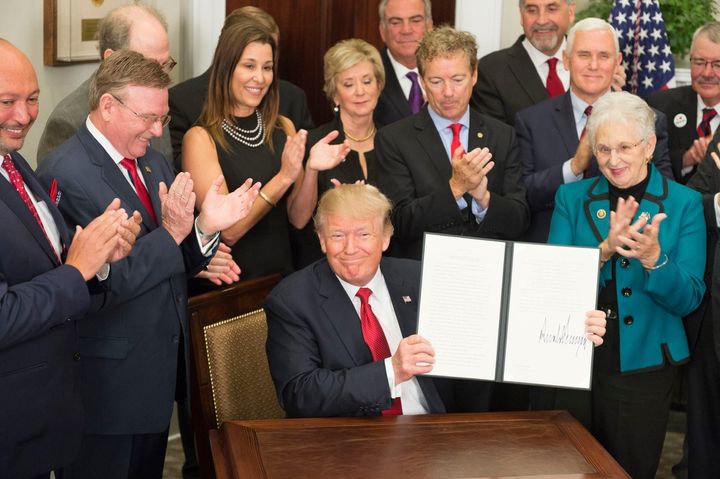Where It Stands Today and How it Affects Consumers
Welcome to Trumpcare. It was supposed to be the first year of Obamacare under the Trump administration and believe it or not, the Affordable Care Act (ACA) is seemingly alive. But with what seems like a constant barrage of executive orders, repeal bills, cutbacks, criticizing tweets, and contentious town hall meetings, the law is as bruised and battered as a prize fighter after 12 rounds. With so much change implemented by the new president, it’s not recognizable as Obamacare anymore.
How did we get here? Here’s a rundown of how Obamacare has been hammered into Trumpcare.
January 20, Inauguration Day: President Trump issues an executive order (Minimizing the Economic Burden of the Patient Protection and Affordable Care Act Pending Repeal) that directs agencies to weaken enforcement of the individual mandate. As a result, the IRS states that it will accept tax returns even if taxpayers fail to indicate whether they have qualified coverage. Many insurance companies voiced their concern that an unenforced individual mandate will result in healthy people opting out of buying insurance, thereby increasing costs for those who remain.
January 26: HealthCare.gov cancels millions of dollars in advertising for the remainder of the open enrollment period. Experts estimate that this cut enrollment by 500,000.
April 18: The Centers for Medicare and Medicaid Services (CMS) enacts a shortening of the open enrollment period from three months to six weeks.
May 4: The House passes a repeal-and-replace bill (American Health Care Act of 2017), sending it to the Senate. When the Congressional Budget Office (CBO) estimates millions will likely lose insurance coverage under the plan, many House Republicans who voted for the bill openly call for the Senate to provide an improved bill.
July 28: After struggling to craft a more robust repeal-and-replace bill, the Senate fails to pass the “skinny” healthcare bill when John McCain issues the famous thumbs down on the Senate floor deep into the night. His vote, along with those of Susan Collins (R-ME) and Lisa Murkowski (R-AK), tip the balance below the 50 votes needed to send the bill to the House.
August 31: The Trump administration announces a 90% cut in ACA advertising for the open enrollment period. The administration also announces a cut of approximately 40% in funding to nonprofit Navigator groups that help promote and facilitate enrollment.
September 26: The Senate again attempts to pass a repeal-and-replace measure, this time known as the Graham-Cassidy bill. The bill never makes it to a vote because it becomes apparent that the Republicans will not have the votes again, with Senators McCain, Collins, and Rand Paul once more stating their opposition.
October 6: President Trump makes a ruling that broadens which companies can exempt themselves from covering contraceptives, such as birth control pills, on religious or moral grounds. Nonprofit organizations, for-profit publicly traded companies, and higher-education institutions can now opt out of providing contraceptive care for their employees.
October 12: President Trump issues an executive order (Promoting Healthcare Choice and Competition Across the United States) that instructs his agencies to “consider proposing regulations or revising guidance, to the extent permitted by law” within 60 days to allow association health plans (AHPs), eliminate restrictions on short-term health plans, and expand the use of health reimbursement accounts (HRAs). Supporters say that these changes will allow for plans unencumbered by Obamacare rules, while detractors say they will offer lower-value plans and siphon healthy people away from ACA policies, thereby driving up the cost of those plans for people who need them. However, it remains to be seen if and when these plans will be available.
October 13: President Trump announces that he will cease making payments to insurance companies that funded cost-sharing reductions for nearly 6.5 million low-income consumers. While eligible consumers will still have their out-of-pocket costs reduced, in order for insurance companies to cover the lost funding, premiums are expected to rise by an additional 20%.
And, with that, we have transitioned from an Obamacare world to a Trumpcare one.
What Does This Mean For Consumers?
Trumpcare will have some similarities to Obamacare, but the differences are significant. Here are seven things consumers need to know.

President Donald J. Trump signs the Executive Order to Promote Healthcare Choice and Competition | October 12, 2017
- The open enrollment period is much shorter this year. It’s gone from three months to only 45 days. Consumers need to make a decision about switching or keeping their current plans between November 1 and December 15 in most states. (Exceptions are CA, CO, CT, MA, MN, NY, RI, WA, and the District of Columbia.)
- Obtaining assistance with choosing or enrolling in a health plan may be harder. President Trump reduced 90% of the advertising budget for healthcare.gov and about 40% of the budget for nonprofit enrollment assistance from the Navigator program. But all’s not lost. Consumers can still turn to insurance agents for help.
- Despite claims that it won’t be enforced, the tax penalty is still legally in place and could set scofflaws back $695 per adult in a family and $347.50 per child under 18, with a maximum of $2,085, or up to 2.5 percent of the family income, if you go without qualifying coverage.
- Premium subsidies are also still available and will dampen the rate increases seen in headlines. Consumers should, on average, pay approximately $100 a month after subsidies, which is not too much different than in prior years.
- At the moment, there is at least one insurance company operating in every county in the nation. I say “at the moment” because some are concerned that President Trump’s refusal to fund cost-sharing reduction (CSR) payments will cause some companies to back out at the last minute. Time will tell.
- Speaking of CSRs, they will still be available on silver plans for low-income consumers (those with household incomes of 250% or less than the federal poverty level). The CSRs decrease consumers’ deductibles and other out-of-pocket costs. However, with President Trump ceasing to make payments to insurance companies to cover these reductions for consumers, insurance companies are expected to increase premiums by 20%, according to the Congressional Budget Office.
- Not so fast? With 18 states and the District of Columbia suing the Trump administration over the CSR cutoff, the payments have a possibility of sticking around. Additionally, a bipartisan attempt by a congressional committee would fund CSRs for up to two years. But the president would need to sign off on the measure, and that seems unlikely.
President Trump has made his disdain for Obamacare clear for a long time. With the changes he’s made this year, including the most recent announcements, President Trump is certainly making his mark on healthcare. Obamacare is no longer. We live in a Trumpcare world now.
Michael Z. Stahl is two-time author, insurance expert, and an Executive Vice President at HealthMarkets.
